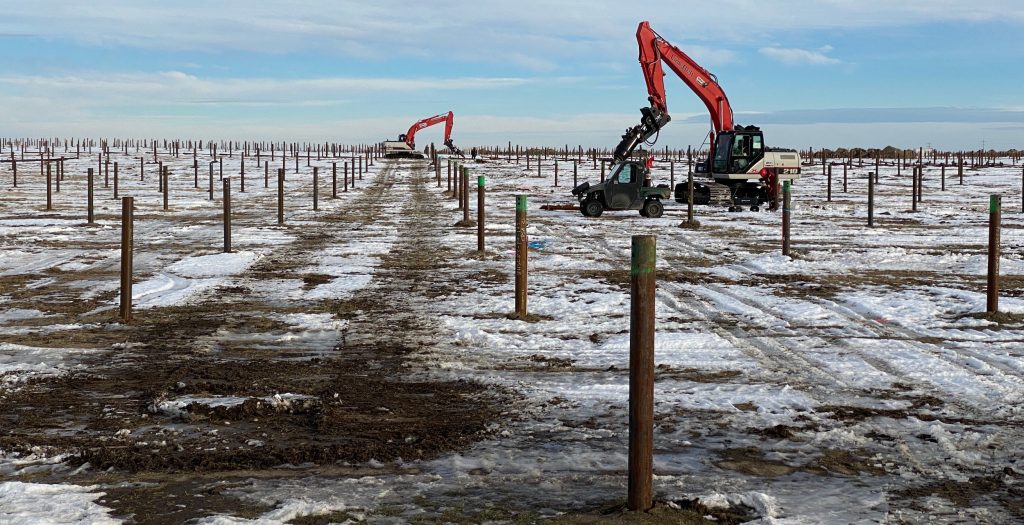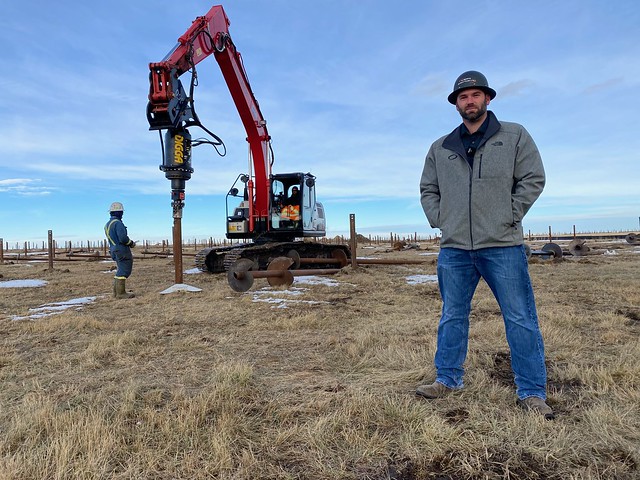By David Dodge and Kay Rollans
We call it the dance of the screw pile excavators: numerous huge machines, guided by human “swampers,” slowly moving through the steps of screw pile installation in an elegant, carefully choreographed ballet, all against the cool, breezy southern Alberta backdrop of the Claresholm Solar Project.
We caught the dance on time-lapse video, which, when viewed at high speed, transforms the delicate ballet into a sprightly hop: an ode to economic opportunity.
But we weren’t at Claresholm Solar Project just for the entertainment. We were there to explore how businesses associated with renewable energy are booming—and how screw piles are playing an important role.
Screw piles lost to time?
Screw piles were invented by Alexander Mitchell, an Irish Engineer in 1833, as a way to create a safe and sturdy foundation for light houses. They’re simple, and they’re cost effective—and they’ve been somewhat lost to time.
Until recently.
In the 1980s, some engineers began to expand the use of screw piles into other contexts. But when Bryce Bernhard came to Alberta in 2010, he realized they were still a dramatically underutilized technology.
Bernhard met his Albertan wife Charleen in Texas. The couple moved up to Alberta in 2010 with very little in tow. “I had $1,800 and a…1999 Dodge pickup and a U-Haul trailer and one bag of tools,” says Bernhard.
His plan was to start a construction company in the province, but with so much competition in the space Bernhard needed a competitive edge.
Enter screw piles.
They’re a deceptively simple technology: each pile is a steel pipe with blades on one end (think of a giant screw). You literally screw the piles into the ground, and in minutes you’ve installed an incredibly sturdy foundation.
Early on, Bernhard realized that screw piles are a simple, very cost-effective way to build foundations for all manner of projects. He also recognized that, despite its being around for a long time, this was a seriously underutilized technology.
Screw piles became Bernhard’s secret sauce, giving him a competitive edge and allowing him to land important jobs in construction.
This led Bernhard to start Alberta Screw Piles Ltd. In 2010. After a few years of fighting to establish their presence in the marketplace, they started landing projects such as backyard decks, municipal buildings, and solar and other applications on farms.


Then, “in 2017 we started getting some bigger industrial work and then that was the year that the cannabis facilities really started popping up and we did a number of those, I guess starting with Aurora Sky and Aurora Sun. So that was thousands of piles over there, a couple of years’ span,” says Bernhard.
It’s been a meteoric rise since then. They did the Amazon warehouse in Nisku and, notably, a boardwalk across a lake, highlighting another great use for screw piles. The piles can be installed when the lake is frozen, and cause very little disturbance to the delicate ecosystem.
Solar Screw Piles Photo Gallery
God’s gift to solar
Through it all, Bernhard discovered screw piles are God’s gift to solar. They are the quickest, most effective, and most economical way to build a solar farm. Moreover, when things go well, the pile screws into the ground with zero extraneous disturbance to the land, just like a wood screw into wood, lending yet another layer of environmental stewardship to solar projects.
Eventually Bernhard’s company landed the Claresholm solar project and set out to install 53,000 screw piles out on the prairie just east of Claresholm, Alberta.
At 132 megawatts Claresholm is the largest solar project in Canadian history and when complete will have more than 477,000 solar modules mounted on those 53,000 screw piles that Bernhard’s company is installing.
We travelled to Claresholm to see the project and stayed in the RCMP room at the Bluebird Motel. (No we didn’t get arrested—this is a themed room at one of the oldest motels in town, with tons of exceedingly romantic pre-reconciliation artwork, a framed uniform, and decorations that looked as though they were taken out of my grandparents’ home, 40-50 years ago! Don’t get me wrong; it was actually a pretty cool room.)
We met up with Lee Drombrowski, one of Bernhard’s site managers for a tour of the solar farm. The scale of this project is breath-taking. Lee uses a truck and a side-by-side quad to get around the site, which is several square kilometers in size.

There were thousands of screw piles laying in a row on the ground, ready for installation. Tens of thousands had already been installed.
The team can install up to 400 screw piles in a day. On the day we toured the solar project, there were about ten excavators involved in the dance of the screw pile excavators.
Solar means jobs, even in an economic crisis
Fairly early on in the project, Bernhard’s crew grew to 60 as the challenges of the landscape became more tangible. Though prior testing had indicated that there would be a few rocky areas, they encountered some large rocks that required some excavation in order to complete installation of some of the screw piles.
We also saw rows and rows of parked cars. Beyond Bernhard’s crew, there were also crews installing the solar racking and crews installing solar.
Even so, as I sat in the construction office, the guys were talking about how the construction company needed 100 more workers to install solar modules. Yup—they had even more jobs to fill.
Bernhard’s business, Alberta Screw Piles Ltd., is very busy these days. Even in these hard economic times exasperated by the COVID-19 pandemic Bryce Bernhard counts his blessings every day for his company’s success.
“Oh, it’s huge. I never expected to be here on a good day and to be here on a bad day and with COVID, and with the economy and the challenges that Alberta has to diversify and to keep people employed. It’s a huge blessing to be a part of this on a good day and to be here with the challenges on a world scale that we have is unbelievable,” says Bernhard.
Bernhard is bidding on a number of other solar projects right now (one of which is four times the scale of the Claresholm project!) but he’s also very enthusiastic about the incredible potential for screw piles in all aspects of the construction industry.
“Back when I started, I was told that three per cent of the deep foundation industry was using helical piles. So, we have 90 per cent opportunity to grow within an existing industry,” says Bernhard.
Ok, this seems like funny math, but one thing is definitely true: there is massive potential for growth in this industry, and every day that Bernhard crew works on big projects like the Claresholm project, they get better and better at doing the job more efficiently.
A bright, solar future for screw piles
Bernhard sees much more potential in renewable energy. He says there is a huge opportunity to grow “screw piles and helical pile foundations for all renewable energy infrastructure, whether it’s the power lines, whether it’s the substations, whether it’s the solar or the wind towers—these can all be sustained by screw piles.”
Yup wind power is also booming and Bernhard hasn’t even started working in that market.
It was Colin Grindle of Alberta Screw Piles that initially pitched us on this story.
I must confess though that at the time when he started talking about single helix screw piles or double helix screw piles my eyes started to glaze over. Now, having seen them in action and seeing how the industry is booming along with the solar industry, he’s definitely got our attention.


